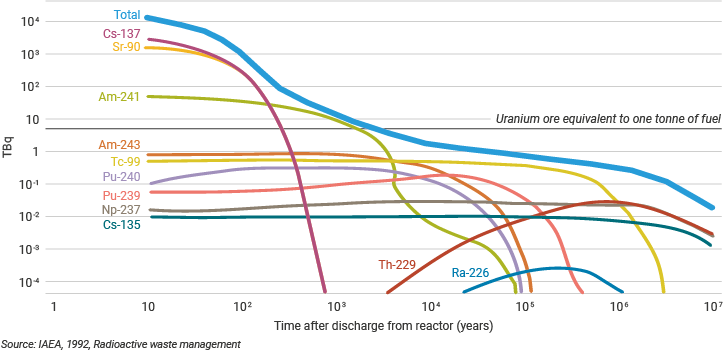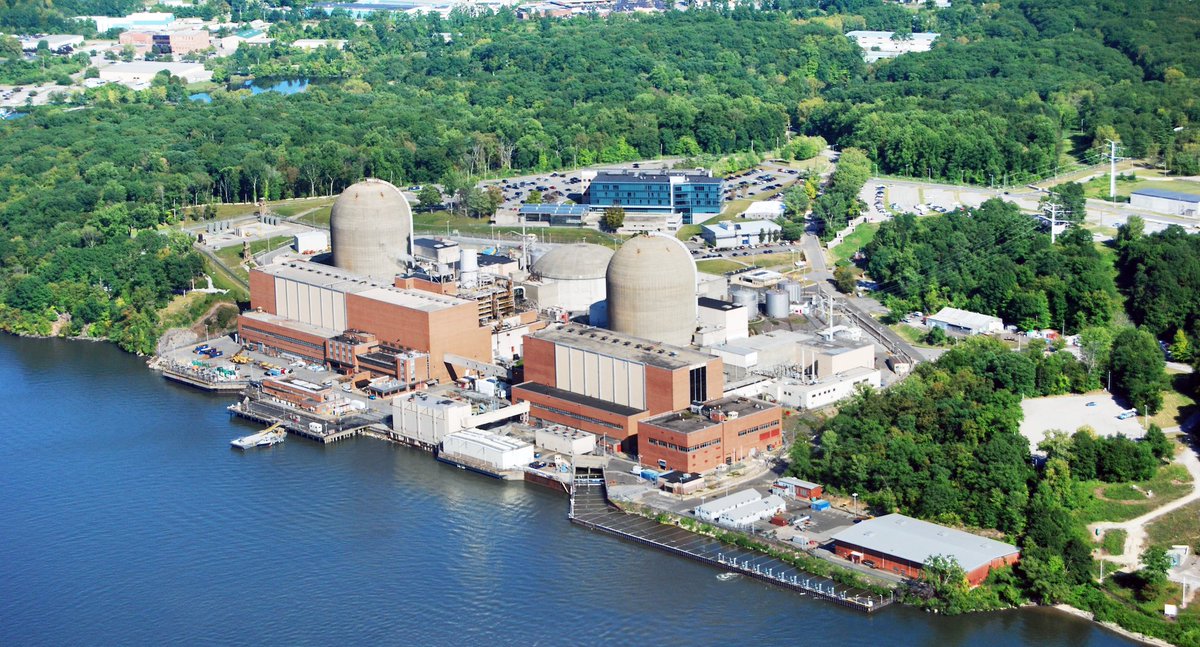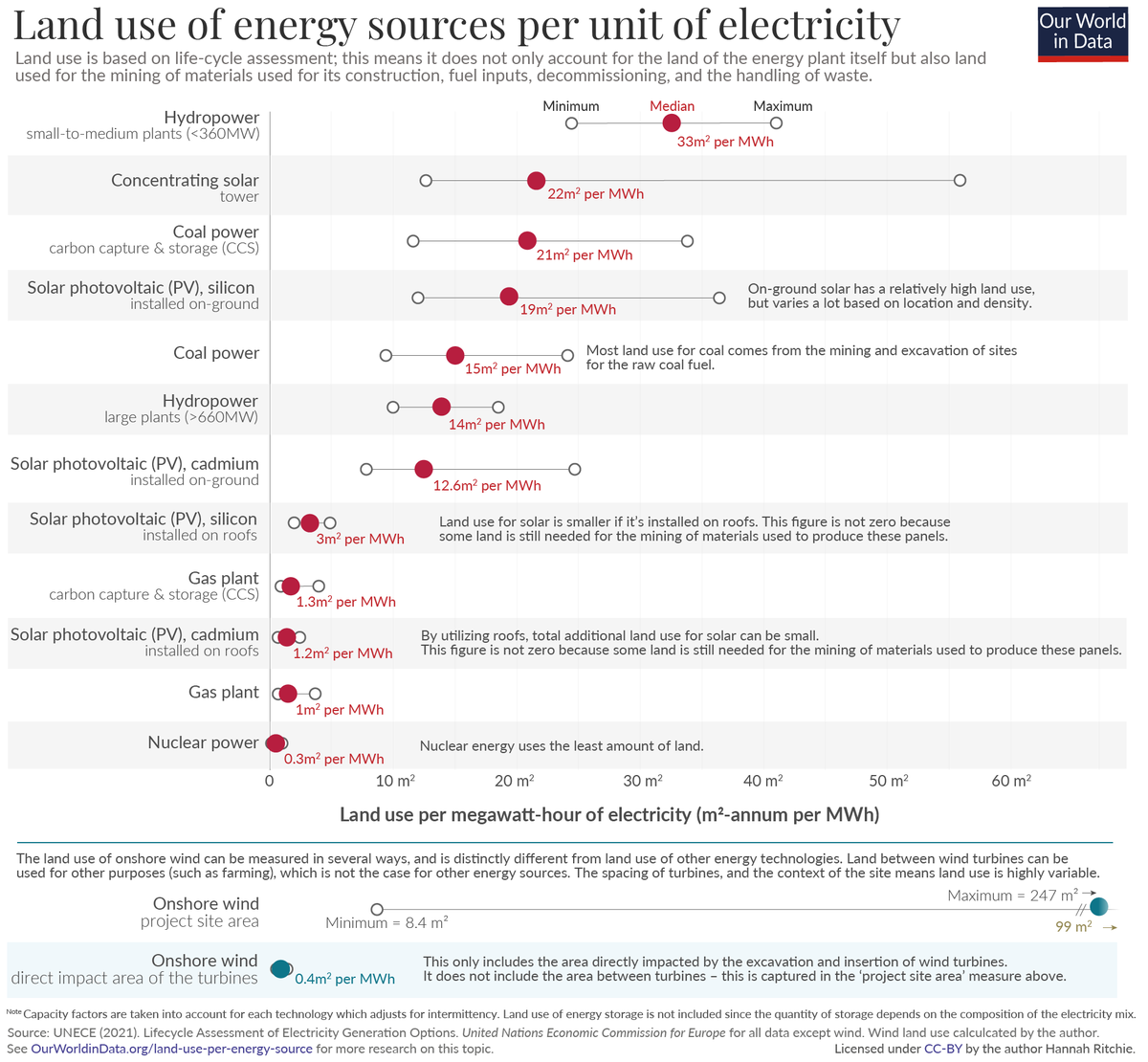My thread on nuclear waste seems to have touched a nerve!
Interestingly, most pushback has come from INSIDE the nuclear industry, not outside.
A follow-up on the physics & culture of nuclear waste, & why the industry has gotten it wrong for so long:
Interestingly, most pushback has come from INSIDE the nuclear industry, not outside.
A follow-up on the physics & culture of nuclear waste, & why the industry has gotten it wrong for so long:
https://twitter.com/MadiHilly/status/1550148385931513856
When people want to talk about the waste, they want answers to two questions:
1. Is the waste safe today?
2. Is the waste safe after the apocalypse?
Let’s start with the first.
1. Is the waste safe today?
2. Is the waste safe after the apocalypse?
Let’s start with the first.
The rule of thumb for radiation is as follows:
Short half-life means higher radioactivity (think spicier) but for a shorter time.
Long half-life means lower radioactivity (less spicy) but for a longer time.
Short half-life means higher radioactivity (think spicier) but for a shorter time.
Long half-life means lower radioactivity (less spicy) but for a longer time.

Very short half-life products are of little concern here because, by definition, they've lost most of their radioactivity by the time the fuel rods have been sitting in water for several years.
Therefore much of waste management is dealing with longer-lasting fission products.
Therefore much of waste management is dealing with longer-lasting fission products.
There are two categories of “waste” to deal with:
1. Fission products (atomic “fragments” lighter than uranium)
2. Transuranics (radioactive elements heavier than uranium)
Both types are contained within ceramic pellets that make up the fuel pellets inside of the fuel rods.
1. Fission products (atomic “fragments” lighter than uranium)
2. Transuranics (radioactive elements heavier than uranium)
Both types are contained within ceramic pellets that make up the fuel pellets inside of the fuel rods.
Fission products like Cs-137 and Sr-90 come from the splitting of uranium.
Fission products typically have shorter half-lives compared to transuranics. As such, they are responsible for most of the heat and penetrating radiation of the waste.
Fission products typically have shorter half-lives compared to transuranics. As such, they are responsible for most of the heat and penetrating radiation of the waste.

Transuranics like Am-241 & Pu-240 are the result of uranium absorbing neutrons but not fissioning.
They usually have a long decay chain which gives them a long effective half-life. They don’t produce nearly the heat of fission products, but their radiation sticks around longer.
They usually have a long decay chain which gives them a long effective half-life. They don’t produce nearly the heat of fission products, but their radiation sticks around longer.

Transuranics can be "eaten up" in breeder reactors, meaning they can become fuel and then fission products.
This would make the remaining waste short-lived compared to traditional spent fuel.
This would make the remaining waste short-lived compared to traditional spent fuel.
I asked radiation expert @ThatRadGuy5 about a worst case scenario: what if a cask got cracked open?
“If the cask were damaged, it would not be catastrophic. If anything, it would just lose its seal and lose inert helium gas. Essentially all material would stay contained.”
“If the cask were damaged, it would not be catastrophic. If anything, it would just lose its seal and lose inert helium gas. Essentially all material would stay contained.”
I urged him to use his imagination.
“It would not be a good day (an accident that was severe enough to damage a cask would need to be unprecedented), but there would likely not be harm caused by radiation, and the land would not really be affected.”
“It would not be a good day (an accident that was severe enough to damage a cask would need to be unprecedented), but there would likely not be harm caused by radiation, and the land would not really be affected.”
That gets to the heart of my 1st thread: there are many other materials that are more hazardous and that we store in less secure ways.
Anhydrous ammonia (used for fertilizer) is far more dangerous, but we make & transport millions of metric tons per year because it feeds us.
Anhydrous ammonia (used for fertilizer) is far more dangerous, but we make & transport millions of metric tons per year because it feeds us.
So we know the waste is safe today. When it's in casks, you can lie on it, stand on it, hug it, whatever.
Time to get to the doomsday question: what happens to the waste after the apocalypse?
Over the past 5 years, I’ve been asked about the following scenario MANY times:
Time to get to the doomsday question: what happens to the waste after the apocalypse?
Over the past 5 years, I’ve been asked about the following scenario MANY times:
"What if, thousands of years from now, someone comes across casks containing nuclear waste? Encountering them for whatever reason, from bad luck to curiosity. And what if they don’t read English but possess the brute power to cut through thick reinforced concrete and steel?"
You can’t understand this question if you take it at face value.
We already know that nuclear waste isn’t uniquely dangerous.
We've had written material passed along & understood for 4500 years, give or take.
Radiation detection devices are cheap and widely available.
We already know that nuclear waste isn’t uniquely dangerous.
We've had written material passed along & understood for 4500 years, give or take.
Radiation detection devices are cheap and widely available.
But this post-apocalyptic scenario provides insight into how people think about nuclear power.
Folks asking this question are imagining there will be a “clean slate” apocalypse, which is almost always represented as a nuclear apocalypse.
Folks asking this question are imagining there will be a “clean slate” apocalypse, which is almost always represented as a nuclear apocalypse.
*When people are asking this question, they are expressing their nuclear fears in the present by projecting them onto the future and onto the waste*
In many minds, there is no difference between nuclear power plants and nuclear bombs.
Cask of nuclear waste = small nuclear bomb
Nuclear plant = big nuclear bomb
Cask of nuclear waste = small nuclear bomb
Nuclear plant = big nuclear bomb
Part of this can definitely be chalked up to the anti-nuclear movement (i.e. China Syndrome). Activists intentionally tried to falsely blur the line between the meltdown of a commercial nuclear power plant and the detonation of a nuclear bomb. 

But rather than pushback against the idea that nuclear power & its waste are uniquely dangerous, the industry internalized it!
Industry professionals will tell you the waste is safe. They will also tell you that we have to bury it deep underground or shoot it into the sun.
Industry professionals will tell you the waste is safe. They will also tell you that we have to bury it deep underground or shoot it into the sun.
This is just another example of the nuclear industry trying to respond to social concerns with costly technological “solutions”.
But ironically because of the sheer cost and effort involved, those fears are *confirmed*, not diffused.
But ironically because of the sheer cost and effort involved, those fears are *confirmed*, not diffused.
To be clear, this thread is NOT an argument to be less intentional about our plan for proper waste management!
It’s meant to demonstrate the problems that arise when you fail to differentiate between a communication problem and a science problem.
It’s meant to demonstrate the problems that arise when you fail to differentiate between a communication problem and a science problem.
So what should we do with the waste, exactly? People in the industry complained there was no specific plan laid out.
I talked to nuclear energy expert @energybants to outline what the start of a good waste management program should look like.
I talked to nuclear energy expert @energybants to outline what the start of a good waste management program should look like.
Second, build public trust through facilities that manage either reprocessed waste or unprocessed waste in a visually compelling, accessible, and informative way.
@ThatRadGuy5, @energybants and I are all big fans of how the Dutch have pulled this off.
@ThatRadGuy5, @energybants and I are all big fans of how the Dutch have pulled this off.
https://twitter.com/energybants/status/1463972510115024897
Next, put in place a deliberation plan. The Dutch have this too.
They plan to have a geological repository by 2100. Every 10-20 years they touch base on the issue. The result has been “we’re still doing research & watching the rest of the world, talk again in another 10-20.”
They plan to have a geological repository by 2100. Every 10-20 years they touch base on the issue. The result has been “we’re still doing research & watching the rest of the world, talk again in another 10-20.”
In this case, it’s responsible to wait! Everything about nuclear waste gets cheaper the longer you wait, making it the exact opposite of every other infrastructure project we work on.
And we know it’s safe today, so what’s the rush?
And we know it’s safe today, so what’s the rush?
Lastly, we need to leave a fleet of working reactors for future generations. Maintaining systems and protocols makes things easier for everyone involved. And there’s the added benefit of abundant, reliable, carbon-free power.
Win-win!
Win-win!

• • •
Missing some Tweet in this thread? You can try to
force a refresh
























